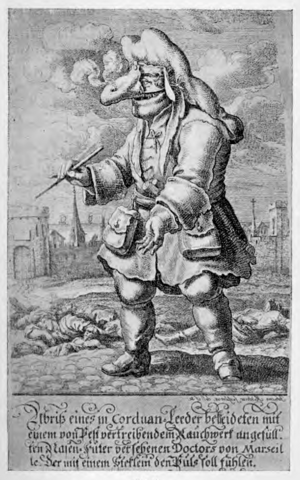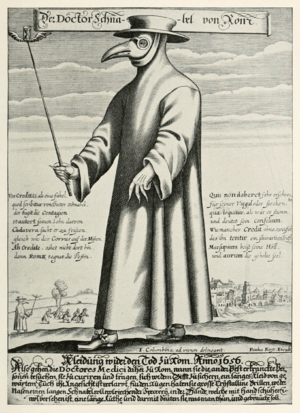Plague doctor costume facts for kids
The plague doctor's costume was special clothing worn by doctors during outbreaks of the plague. These doctors needed to protect themselves from the disease, which was very dangerous. The costume included a long coat, a unique mask shaped like a bird's beak, and other items like gloves, boots, and a hat. People at the time believed bad smells caused the plague, so the beak mask was often filled with sweet-smelling herbs to keep those smells away.
Contents
What Did the Plague Doctor's Costume Look Like?
The most famous part of the costume was the beak mask. This mask was held in front of the doctor's nose with straps. It had two glass-covered holes for the doctor to see through. There were also two smaller holes for breathing.
The Beak Mask's Purpose
The beak part of the mask was often filled with strong, nice-smelling things. These included dried flowers like roses and carnations, herbs like mint, spices, camphor, or a sponge soaked in vinegar. Doctors believed these herbs would keep away "evil" smells. At that time, many people thought bad smells caused diseases like the plague.
Other Parts of the Costume
The costume also had a wide-brimmed leather hat. This hat helped show that the person was a doctor. Doctors also carried a wooden cane. They used the cane to point at areas needing medical attention on a patient. It also helped them examine patients without touching them directly. The cane could also be used to keep people away or to remove clothes from sick people.
How the Costume Actually Helped
Even though doctors thought the costume protected them from bad smells, it actually helped in other ways. The thick leather jacket and other parts of the costume made it hard for fleas or rats to bite the doctor. Fleas often carried the plague. The leather also stopped infected people from touching the doctor, which helped prevent the spread of the disease.

The History of the Plague Doctor's Outfit
Some people today think that plague doctors in the 1300s wore bird-like masks. However, experts on medical history say the famous plague doctor costume was actually invented much later. It was created by a man named Charles de Lorme in 1619.
Charles de Lorme's Design
Charles de Lorme designed the costume to be full head-to-toe protection. It was inspired by a soldier's armor. The outfit included the bird-like mask and a long gown made of leather or waxed canvas. This gown went from the neck all the way down to the ankles. Other parts, like leggings, gloves, boots, and a hat, were also made of waxed leather. The entire outfit was often treated with the same sweet-smelling items used in the beak mask.
A Poem About the Costume
A poem from the 1600s describes the plague doctor's costume:
- As may be seen on picture here,
- In Rome the doctors do appear,
- When to their patients they are called,
- In places by the plague appalled,
- Their hats and cloaks, of fashion new,
- Are made of oilcloth, dark of hue,
- Their caps with glasses are designed,
- Their bills with antidotes all lined,
- That foulsome air may do no harm,
- Nor cause the doctor man alarm,
- The staff in hand must serve to show
- Their noble trade where'er they go.
Later Sightings of the Costume
In 1721, a book called Treatise on the Plague by Jean-Jacques Manget described the costumes worn by plague doctors in Nijmegen during 1636-1637. A picture of this costume was at the front of the book. These doctors also wore beaked masks. Their robes, leggings, hats, and gloves were made of morocco leather.
The costume was also worn during the Great Plague of 1656. This terrible plague killed many people, including 145,000 in Rome and 300,000 in Naples. The sight of the plague doctor in this costume often made people very scared. It was a sign that death might be near.
The Costume in Culture
The plague doctor's costume became part of a type of Italian theater called commedia dell'arte. There was a character named Il Medico della Peste, which means "the Plague Doctor." He wore a special plague doctor's mask.
Venetian Carnival Mask
The Venetian mask was usually white. It had a long beak and round eye-holes covered with clear glass. This unique mask is still one of the most famous masks worn during the Carnival of Venice today.
Images for kids




